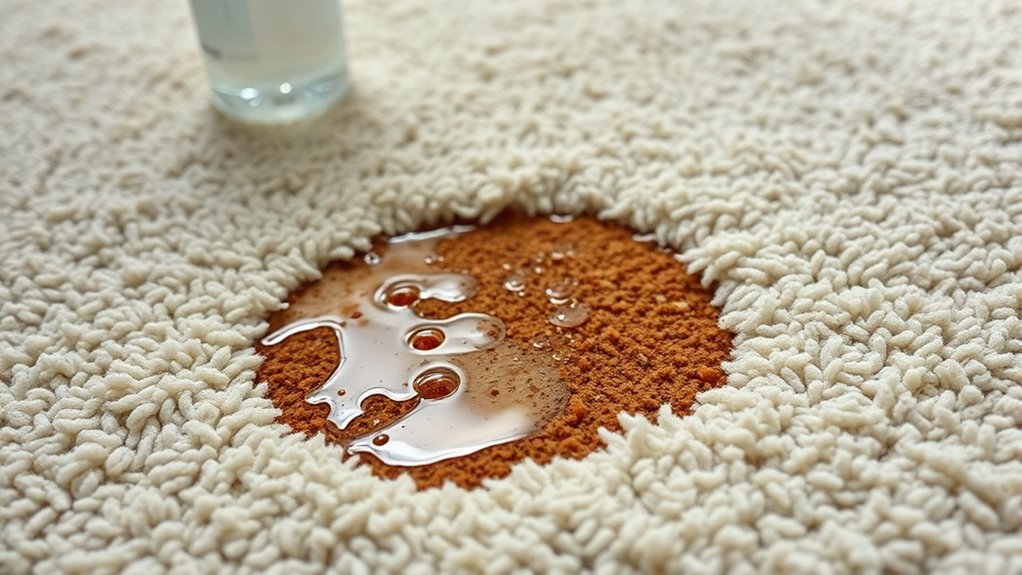When pet vomit hits your carpet, start by removing solid debris with a paper towel or spoon. Blot the stain gently to soak up moisture, then apply an enzyme cleaner formulated for pet stains. Let it sit for the recommended time so the enzymes can break down organic matter effectively. Afterward, blot again to lift the residue and odors. For thorough cleaning, consider steam or hot water extraction, and make certain the area dries completely. Learning more will help you restore your carpet’s freshness effortlessly.
Key Takeaways
- Blot and remove solid debris immediately with a paper towel or spoon to prevent deeper embedding.
- Apply an enzyme cleaner directly to the vomit stain, ensuring full coverage for effective breakdown.
- Let the enzyme cleaner sit for the recommended time to allow enzymes to digest organic matter.
- Gently blot or rinse the area with water after treatment, then blot dry to remove residue.
- Repeat the enzyme application if odors or stains persist, maintaining regular cleaning for ongoing freshness.

Have you ever wondered how to quickly and effectively clean pet vomit from your carpet? When accidents happen, you need a solution that not only removes the stain but also eliminates odors and prevents future issues. That’s where understanding pet stain removal and proper carpet cleaning techniques come into play. The key is to act fast, so the stain doesn’t set, and to use the right products and methods to guarantee your carpet remains fresh and clean.
Start by removing any solid debris with a paper towel or a spoon, being careful not to push it further into the fibers. Blot the affected area with a clean cloth to soak up as much liquid as possible—avoid rubbing, as this can spread the stain and embed it deeper. Once you’ve absorbed the excess, it’s time to tackle the stain with a suitable cleaning solution. Many commercial pet stain removers are designed specifically for this purpose, but you can also prepare a homemade solution using a mixture of water, white vinegar, and a few drops of dish soap. Spray or apply this mixture directly onto the stain, then let it sit for several minutes. This helps break down organic matter and neutralizes odors.
Remove solid debris carefully, then blot with a clean cloth to absorb excess liquid and prevent deeper stains.
When you’re ready to clean, use a clean cloth or a wet vacuum to extract the solution along with the stain. For stubborn spots, a soft-bristled brush can help lift the residue from the carpet fibers. Rinse the area with plain water and blot again to remove remaining cleaning solution. This step is vital because leftover soap or cleaning agents can attract dirt, making your carpet look dull over time.
To guarantee your carpet is thoroughly cleaned and odor-free, employing effective carpet cleaning techniques is essential. Steam cleaning or hot water extraction offers a deep clean that reaches beneath the surface. If you prefer a DIY approach, use a carpet cleaning machine or rent one to thoroughly flush out residues. After cleaning, don’t forget to dry the area completely, as moisture can promote mold or mildew growth.
Using enzyme cleaners specifically formulated for pet stains is highly effective because enzymes break down the organic compounds in vomit, erasing stains and odors simultaneously. Apply these enzymes generously, following the manufacturer’s instructions, and allow ample time for them to work. Regular maintenance with these products guarantees your carpet stays fresh and free of lingering pet smells. Additionally, understanding the importance of digital literacy programs can help seniors and pet owners alike stay informed about the latest cleaning techniques and products. With prompt action and the right techniques, you’ll be able to keep your carpet looking and smelling like new, even after those unexpected pet accidents.
Frequently Asked Questions
How Long Should I Wait Before Reapplying Enzyme Cleaner?
You should wait at least 24 hours before reapplying enzyme cleaner, following the timing guidelines for effective odor removal. Allow the initial treatment to fully work and dry before contemplating reapplication. Check the product instructions for specific reapplication frequency, as some enzymes may need a second treatment if odors persist. Patience is key; reapply only when necessary to avoid overuse and ensure the enzymes have time to break down the stain.
Can Enzyme Cleaners Be Used on Delicate or Colored Carpets?
Think of your carpet as a delicate painting—its colors, like emotions, deserve gentle care. When considering enzyme cleaners, check if your carpet is colorfast or delicate; most enzyme formulas are compatible with colorfast fabrics. For delicate or colored carpets, choose enzyme cleaners labeled safe for delicate fibers. Always test a small, hidden area first to verify enzyme compatibility, preserving your carpet’s beauty while effectively removing stains.
Is It Safe to Use Enzyme Cleaners Around Pets and Children?
You can generally use enzyme cleaners around pets and children, but you should check the label to guarantee enzyme cleaner safety. If you have pet allergy concerns, choose products specifically designed to be hypoallergenic and non-toxic. Always follow the instructions, and let the area dry completely before allowing your pets or kids back onto the surface. This way, you minimize any risks related to enzyme cleaner safety and allergy issues.
How Do I Prevent Future Pet Vomit Stains on My Carpet?
To prevent future pet vomit stains, focus on puppy training and regular carpet maintenance. Consistently reinforce house training so your pup learns proper spots. Use protective rugs or mats in high-risk areas, and clean spills immediately with enzyme cleaners to prevent stains. Keep your pet well-hydrated and fed on a consistent schedule. These steps help reduce accidents and keep your carpet cleaner longer.
Are There Natural Enzyme Alternatives for Cleaning Pet Vomit?
Yes, there are natural remedies and DIY solutions you can use as enzyme alternatives for cleaning pet vomit. You might try a mix of baking soda and white vinegar, which helps neutralize odors and break down stains naturally. Additionally, hydrogen peroxide combined with a bit of dish soap can work effectively. These natural remedies are safe, inexpensive, and environmentally friendly, making them great options for tackling pet stains without harsh chemicals.
Conclusion
You’ve just uncovered the ultimate secret to banishing pet vomit from your carpet forever! With this enzyme trick, you’ll turn your chaos into crystal-clear, spotless perfection faster than you can say “fresh and clean.” Say goodbye to lingering stains and foul odors—your carpet will shine brighter than a diamond, and your home will smell like a paradise. Trust this method, and watch your carpet transform into a pristine masterpiece overnight!









